
|
Sale 14
Coins, Collectibles and Memorabilia Auction
| The Dasler Family Collection of Ancient Glass |
| |
| |
| Lot |
Photo |
Description |
Realized |
Lot 4687 |
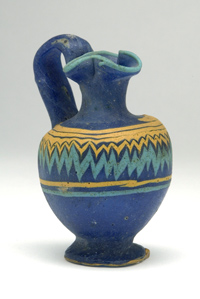 |
A Splendid Core-formed Oinochoe in Blue and Yellow. Cf. G.F.M. fig 23b; Newark, fig. 29; Toledo, Ancient Glass, nos. 114-116. Eastern Mediterranean, possibly from Rhodes, c. late 6th or 5th century BC. Height: 3-1/2". Formed from glass of a deep cerulean blue, the vessel features added colors of turquouise and deep, rich, almost orangey yellow. The body is ovoid-shaped, with a short, rounded foot, and a flared mouth that has been pinched into a trefoil. Separately added at the side, is a thick blue glass loop handle. Along the bottle's shoulder are bands of yellow and turquoise that have been partially marvered into sharp zigzags.Turquoise also edges the mouth, and yellow edges on the foot. This oinochoe is intact and perfect! Some trivial surface etching from age, but most of the luster is more than evident. Museum quality!
Estimated Value $2,500-UP.
View details and enlarged photo
| Realized
$4,370 |
Lot 4688 |
 |
Necklace of Glass Eye Beads. Phoenician, c. 5th to 3rd century BC. Bead Lengths: 1/4" - 7/8". A strand of graduated eye beads in glass, with a few perhaps in faience. The beads are ovoid to nearly spherical, with "eyes" of dotted concentric circles applied to a color base, or matrix. Most beads feature an average of eight eyes on a base of green; one bead is blue on yellow. The strand also has a blue glass "vase" bead on original iron hanger, plus a marvered cylinder bead which is medieval Islamic, or perhaps Egyptian. Beads range from well preserved to well weathered.
Estimated Value $300 - 400.
View details and enlarged photo
| Realized
$805 |
Lot 4689 |
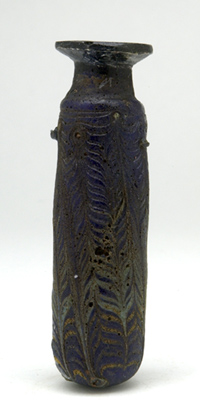 |
Core-formed Alabastron with Marvered Patterning. Cf. G.A.E. Vol. 1, pl. 4d; Toledo, Ancient Glass, 123ff. Eastern Mediterranean, or possibly western Iran, c. 4th to mid-3rd Century BC. Height: 4". This alabstron is formed from dark blue glass, wand features a flanged lip, short thick neck, and sloping and carinated shoulders all atop a long cylindrical body, which is slightly barreled. The body is decorated with rows of marvered yellow and blue bands, which creates a delicate feather-like pattern. Remnants of two small lug handles remain at the sides. The mouth and rim appear restored. Some of the inlaid glass has disolved with time, leaving a pleasantly tactile remebrance of its presence. An affordable example of this rare early glass.
Estimated Value $400 - 650.
View details and enlarged photo
| Realized
$518 |
Lot 4690 |
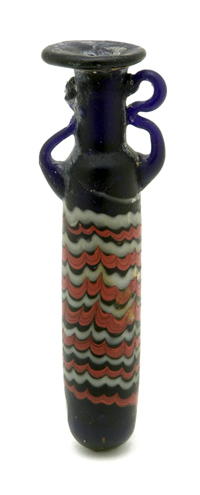 |
Colorful Core-formed Alabstron in Colbalt Glass. Cf. Toledo, Ancient Glass, no. 162. Eastern Mediterranean, probably Phoenician, c. 3rd to early 1st Century BC. Height: 3-3/4". This alabastron is a narrow form, with broad flat top and a rolled lip. The a rather long cylindrical neck has double looped handles attached at the sides and the cylindrical body is slightly barreled. Contrasting with the dark blue hue of the body, encircling bands of white and red glass have been lightly marvered. Aside from chipping to one handle, and slight remnants of a whitish crust, the glass is extraordinarily well preserved. With professional restoration to a singe handle, one could have a key piece that would be the highlight of any advanced collection.
Estimated Value $1,500-UP.
View details and enlarged photo
| Realized
$2,185 |
Lot 4691 |
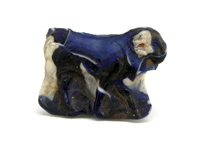 |
Miniature Plaque with Ram. Ptolemaic Egypt, 3rd to 2nd century BC. Size: 1" x 1-3/8". Depicting a ram walking towards the right, this mold-pressed plaque is made of irregularly mixed white and blue glass. The edges show some chipping and trimming. Otherwise the piece mostly complete. Interesting.
Estimated Value $200 - 300.
View details and enlarged photo
| Realized
$564 |
Lot 4692 |
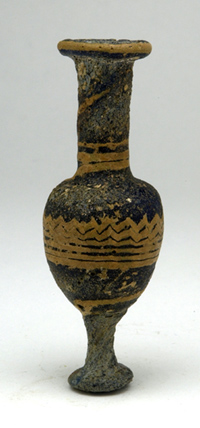 |
Well Crafted Core-formed Amphoriskos. Levant or Italy, 3rd to 2nd century BC. Cf. Toledo, Ancient Glass, no. 158, but of stouter form. Height: 4-1/4". Nicely porportioned, this deep blue glass vessel features a flat everted lip, long cylindrical neck, and inverted rounded conical body set upon a high small foot. Opaque yellow horizontal stripes edge the lip and wind about neck and body. The piece is marverd at the shoulder, along with slight heat tooling to create subtle ribbing along the shoulder's edge. Bottle is intact and perfect with weathered, lightly iridescent surfaces. A very fine example, and noteworthy for being complete.
Estimated Value $900-UP.
View details and enlarged photo
| Unsold |
Lot 4693 |
 |
Important Core-formed Miniature Oinochoe. Levant or Italy, 3rd to 2nd century BC. Cf. Corning, p. 163; Toledo --; Opplander --. Height: 3-7/8". Made from deep blue glass, this vessel features a rounded trefoil lip and inverted, conical body set upon a high foot. A separate blue glass L-shape handle appears on the side. Opaque yellow horizontal stripes edgethe lip and wind about the neck and body. The piece is marverd at the shoulder, along with heat tooling which creates an ornamental ribbing. The upper part of the handle has been restored with a Roman handle, otherwise the bottle is complete. Bottle was likely semi-submerged in moist soil for centuries, as the glass surface along the back of the piece appears quite pristine, yet the front half shows a milky-silvery iridescence. Apparently a rare form.
Estimated Value $800-UP.
View details and enlarged photo
| Realized
$489 |
Lot 4694 |
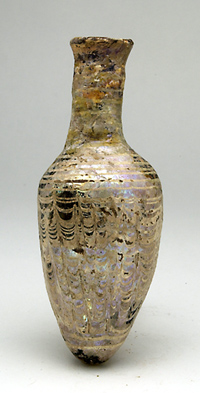 |
Core-formed Amphoriskos. Eastern Mediterranean, 2nd to 1st century BC. Cf. Toledo, Ancient Glass, nos. 168ff. Fashioned in a similar manner to the preceding lots, this piece is comprised of black glass with marverd bands of white. Repairs and restoration appear at the neck, shoulders (where handles would have been), and base. The bottle is mostly covered with fine, opaque, softly metallic silvery violets, greens, and blues.
Estimated Value $350 - 500.
Ex Ainley Collection; Malter XXXVIII, lot 4.
View details and enlarged photo
| Realized
$518 |
Lot 4695 |
 |
Early Roman Bowl, in Deep Amber Colored Cast Glass. Cf. Newark, fig. 33; Han Cohn Collection fig. 31; Toledo, Ancient Glass, nos. 243-246. Roman, perhaps Italy, late 1st century BC. to early 1st century AD. Diameter: 5-1/2". This simple, thick-walled bowl is nearly hemispherical in shape. As usual with this class of bowls, the vessel was made by casting rather than blowing, and the exterior has been smoothed by means of "fire polish," while the interior was finished by means of lapidary techniques. In the interior, two concentric circles have been deeply engraved. Typical for ancient glass of some thickness, this bowl wdoes have a number of stable age cracks. However, repairs and some restoration are noted along a length of the rim. Small speckles of bright iridescence can be seen within the surface recesses of the bowl. An affordable example of this scarce and costly series.
Estimated Value $400 - 600.
View details and enlarged photo
| Realized
$265 |
Lot 4696 |
 |
Cast Blue Ribbed Bowl. Roman Syria or Lebanon, late 1st century BC. to mid-1st century AD. Toledo, Ancient Glass, nos. 231-233; G.A.E. Vol. 1, fig. 128z. Diameter: 5-7/8". This bowl features thirty molded ribs that flare out below a plain, broad rim and depend to the concave bottom. Made by casting rather than blowing, the exterior was finished with "fire polish," while the interior was finished by means of lapidary techniques. Additional engraved concentric circles appear in the interior, over the concave base. Layered over the blue glass are zones of spectacular gold, silver, copper, green and red iridescence. The bowl has a repaired break and some restoration, which is covered with equally bright iridescent patina. A flashy example of its class.
Estimated Value $750-UP.
View details and enlarged photo
| Realized
$489 |
Lot 4697 |
 |
Another Ribbed, Cast Bowl, in Aqua. Roman Syrian, early 1st century AD. Cf. G.A.E. Vol. 1, pl. 40; A.G. fig. 79; Hans Cohn Collection, fig. 41; Toledo, Ancient Glass, nos. 229. Diameter: 6-3/4". Another bowl, similar to the preceding lot. The aqua glass piece, made by casting, rather than blowing, features an exterior with "fire polish" while the interior is finished by means of lapidary techniques. Additional engraving can be seen in the interior: a sunk border beneath rim, and two concentric circles over the concave base. With an age crack that has been stabilized, the thick bowl seems quite sound. Some slight, cleanable dirt, with pleasing transparent iredescence with fine greens reds and magentas.
Estimated Value $900-UP.
View details and enlarged photo
| Realized
$1,035 |
Lot 4698 |
 |
Early Roman Bowl in Light Green Glass. Roman, 1st century AD. Diameter: 6-1/4". This simple bowl is fairly shallow but finely proportioned. Made by casting rather than blowing, the exterior shows "fire polish" while the interior hs been finished by means of lapidary techniques. Additional engraving seen in the interior include a sunk border beneath rim and two concentric circles over the concave base. Intact and finely preserved, this piece features patches of thick creme-rose iridescence along with transparent but more vivid green, violet, and rose hues around the rest of the interior.
Estimated Value $500 - 800.
View details and enlarged photo
| Realized
$345 |
Lot 4699 |
 |
A Rare Pyxis, in Amber Brown Glass. Roman, perhaps Italy, 1st Century AD. Cf. G.A.W. fig. 64; Newark, figs. 145, 146; Sammlung Oppenlander no. 298. Overall height: 3-3/4". Complete set with bottle and cap. The blown ovoid body is folded into a barrel shape with a ring foot base and ridge shoulder. The separate stopper is essentially a small vial, folded at its center to create a flat, coin-like rim about the middle. The stopper has fine silver-green and violet iridescence. The body shows areas of white patina that also displays equally vivid colors. Some cracks about the body, but the piece apppears otherwise intact and sound. Fascinating and rare!
Estimated Value $400-UP.
View details and enlarged photo
| Realized
$1,006 |
Lot 4700 |
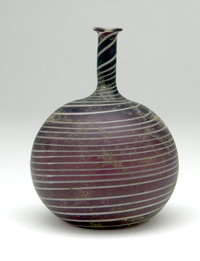 |
Fine "Thread" Bottle. Roman, perhaps Italy, 1st century AD. Cf. A.G. plate VIII, fig. C (Syria 100 to 200 AD); Hans Cohn Collection fig. 82. Height: 3-1/2". Carefully fashioned in blown violet glass, this bottle features a tiny flared mouth, narrow cylinder neck, and globular body with a concave base. From mouth to base the whole bottle isencircled with delicate spiral of white glass. Intact and perfect. An especially choice and colorful example of this charming ware of the Early Empire.
Estimated Value $1,000-UP.
View details and enlarged photo
| Realized
$3,450 |
Lot 4701 |
 |
Sidonian Date Flask, with Vivid Iridescence. Roman Phoenicia, 1st to 2nd century AD. Cf. Newark, fig. 70. Also, Toledo, Roman Mold-blown Glass, nos. 84-107. The author notes that Phoenicia during the 1st century AD. was well regarded for both its glass products as well as its date palms. Perhaps Phoenician artisans were moved to combine their two noteworthies in these little vessels shaped like dates. Length: 3". Mold blown from deep amber-colored glass, the body of this flask resembles the shape of a large, wrinkled date. The neck is short, and slightly flared, while the rim is thick and inwardly folded. Modest repairs appear on the neck and mouth, with slight loss to the base. Most of bottle features a splendid thick, creme-gold iridescence which reflects pastel greens, violets and mauves. Elsewhere, richly colored deep greens, magentas, and blue-violets can be seen. Aside from the small chipping to the base, this is a choice example of this rare and popular type.
Estimated Value $350 - 500.
View details and enlarged photo
| Realized
$661 |
Lot 4702 |
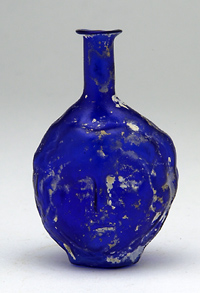 |
Head Flask in Blue Glass. Roman Phoenicia or Syria, 1st to 2nd century AD. Cf. G.A.W., p. 283. Newark fig. 74. Hans Cohn Collection, fig 48. Height: 2-1/2". Mold blown from a deep blue glass, this small vessel features a slight outturned li and, thin cylindrical neck, with its body comprised of two faces (back to back), all set upon a short platform foot. The details of the faces aresoftly molded, but appear to be female. Intact. With remnants of a faintly iridescent calcerous patina. Possibly of Sidonian origin, where the tradition of caput flasks originated, the bottle remains a pleasant and colorful example of its class.
Estimated Value $550 - 750.
View details and enlarged photo
| Realized
$1,035 |
Lot 4703 |
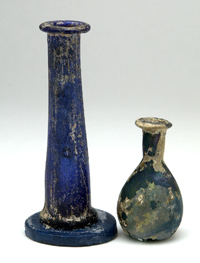 |
Two Colorful Ampules, or Vials, in Blue Glass. Roman 1st to 2nd century AD. Cf. G.A.E. Vol. 1, pl. 89; Newark, fig. 506. Heights: 2-3/8"; 3-3/4". 1. A miniature ampulla, perhaps Syrian, featuring an everted and carinated lip with a short cylinder neck and broad piriform body. The vessel shows areas of a white-silvery patina, while the blue glass displays a vivid, metalic-like iridescence. 2. This small "candlestick" unguentarium is essentially a long flaring neck with a flat, everted mouth and a small flaring, ring-like base. Blown of dark blue glass, the vial is thick and heavy with flecks of silvery iridescence and other scattered colors. Both pieceas are intact and perfect. An excellent lot of two!
Estimated Value $250 - 400.
View details and enlarged photo
| Realized
$472 |
Lot 4704 |
 |
A Pair of Ampulla, or "Tear" Flasks with Vivid Iridescence. Roman, 1st to 2nd century AD. Heights: 3-1/2"; 5-1/2", both mounted on wood bases. Both of similar type, the pair are light and pale green glass with cylindrical necks that are slightly constricted at their bases on piriform bodies. One has a flat, rolled rim to the mouth, while the other is carinated. Both feature mottled iridescence: silvery patches which change color to intense lime green, bright cobalt, or hot coppery colors. A choice pair of bottles.
Estimated Value $200 - 300.
View details and enlarged photo
| Realized
$345 |
Lot 4705 |
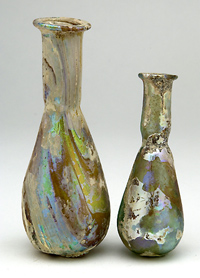 |
Another Pair of "Tear" Flasks with Vivid Iridescence. Roman, 1st to 2nd century AD. Heights: 3-1/2"; 4-1/2". A pair of similar flasks, these appear in yellow and pale green glass with cylindrical necks that are slightly constricted at the base and set on piriform bodies. Both feature flat, rolled rims at the mouths. Each with silvery patches that change in color from intense lime green, and bright cobalt blues, to hot coppery colors. A choice pair of bottles, with color that stays in the mind's eye!
Estimated Value $250 - 350.
View details and enlarged photo
| Realized
$805 |
Lot 4706 |
 |
Two Nice Unguentaria. Roman, 1st to 2nd century AD. CF. G.A.E. Vol. 1, pl. 67; Newark, fig. 401, for first. Cf. G.A.E. Vol. 1, fig 127; Newark fig. 509, for second. Lot of two. Heights: 5-3/8"; 3". 1. The larger piece is green glass with a wide, flat everted lip and a long cylinder neck on a short conical body. Intact and perfect, with appealing translucent to brightly metallic green, silver, copper and blue iridescence. 2. The second piece is similar but miniature, in green-tinged light yellow glass with a drop body set upon a thick, folded foot. Intact with lightly weathered and lightly irdescent surface.
Estimated Value $200 - 350.
View details and enlarged photo
| Realized
$345 |
Lot 4707 |
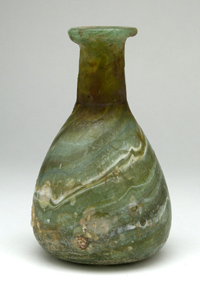 |
Large, Heavy Flask in Marbled Glass. Roman Syria, 1st to 2nd century AD. Cf. G.F.M. fig. 38 (Syrian 1st century A.D.); G.A.E. Vol. 1, pl. 43h & 44; Hans Cohn Collection, fig. 36; Sammlung Opplander, nos. 371ff. Height: 6". Large and robustly made, this unguentarium flask is fashioned from a marble-like glass having opaque white and brown irregular bands set in a light green matrix -- very much resembling a greenish alabaster. With a wide mouth and thick everted rim, this bottle has a short cylindrical neck set on a broad piriform body. Old repairs appear on the neck and side. Otherwise the glass is choice and fresh. Early Imperial marble glass is scarce and avidly collected. Having the old repairs properly and professionally redone would give one a significant glass object of museum quality.
Estimated Value $900-UP.
View details and enlarged photo
| Realized
$776 |
Lot 4708 |
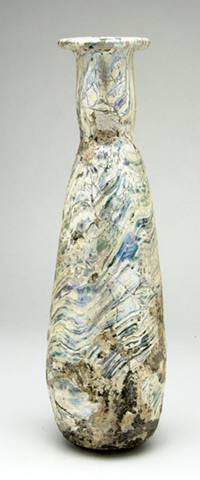 |
Large and Rare Tear-shaped Flask, in Marbled Glass(?). Possibly Roman Alexandria or Sidon. Cf. Hans Cohn Collection, fig. 37; note also, Ede, Collecting Antiquities, fig. 301c, a smaller (6-5/8") but closely similar example in translucent green with opaque white bandings. 1st to 2nd century AD. Height: 10". Fashioned from very thick, opaquish-translucent green glass, this bottle is either blown or perhaps built up over a core. The mouth has a thick, shelf-like outfolded rim; the large cylindrical neck has a constricted juncture just before the long, pear-shaped body. With a rounded, concave base. The surface is heavily patinated and iridescent -- almost completely covered with wavy striations of a milky white-silver, purple, blue, green and gold iridescence. Judging by the irregular and striated patterning of the time-etched glass, the bottle would appear to be made of "marbled" glass similar to the preceding lot. The marblized series of vessels are always rare and sought after. If this is the case, this bottle is especially rare for being the largest example of this glass type of which we are aware. The bottle shows numerous but stable age cracks. Some repairs, and likely some modest restoration.
Estimated Value $1,000-UP.
View details and enlarged photo
| Realized
$863 |
Lot 4709 |
 |
Lot of Two Stylish Unguentaria. Roman, 1st to 2nd century AD. Cf. G.A.E. Vol. 1, pl. 67; and, A.G. l. 75 for smaller; for second, Newark fig. 425. Heights: 4-5/8"; 8". Lot of two delicate long-necked bottles blown from clear and green glass. Both are of a similar form but the smallest features a flattened ovoid body, while the larger has a constricted neck and hemisperical body with a deeply concave base. Both are intact and perfect. The smaller bottle has a translucent to near opaque white and silver-gold iridescence. The larger piece displays a brown-green to silvery iridescence. A handsome pair, with distinctive shapes.
Estimated Value $250 - 400.
View details and enlarged photo
| Realized
$426 |
Lot 4710 |
 |
Flask with Stylish Bell-shaped Body. Roman, 1st to 2nd century AD. Said to have been found in Pergamum. Height: 6-1/8". This very substantial bottle is blown from light green glass. Its mouth has a very thick, rolled and everted rim and a narrow, slightly flaring neck that is attached to the rounded lower body that is a flaring cone shape. The base is very deeply concave. Intact and perfect. With thin, transparent iridescence featuring quite appealing bright greens, magents, and copper hues. Well proportioned and symmetrical. A very fine bottle.
Estimated Value $350 - 500.
View details and enlarged photo
| Realized
$322 |
Lot 4711 |
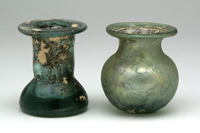 |
Lot of Two Attractive Cosmetic Vessels. Roman, 1st to 2nd century AD. Cf. Newark, fig. 517, for first. The second found in Israel, near the Ayelet Hashahar Kibbutz, Upper Galilee. Cf. Newark, fig. 139. Heights: 2-1/8"; 2-1/4". 1. A miniature ampulla with a wide and flared mouth that has a broad folded lip and a short neck on this spherical body. Blown from fairly thick light green glass. With pleasing silvery-violet iridescence, tending to blues and light magentas, with occasional copper. 2. The second piece is a short unguentarium of exceptionally heavy, thick-walled green glass. The mouth has a broad flat rim with a wide cylindrical neck and short flattend conical body. Two age cracks seen, but the bottle is very stable and strong. This piece shows only faint, transparent iridescence. A good lot!
Estimated Value $250 - 400.
View details and enlarged photo
| Realized
$196 |
Lot 4712 |
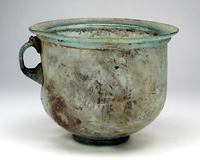 |
Large Cup or Stein. Roman Asia Minor, late 1st to 3rd century AD. Cf. G.A.E. Vol. 1, fig. 128z. Height: 4-7/8"; Width: 6-3/4". Nicely crafted in aqua blue glass, this remarkably large cup has an out-flared rim and an over folded and rolled throat atop its wide cylinder body. The vertical sides merge into a rounded bottom which rests on a thick, rolled, ring foot. In the same glass, a wide, channel-like trailing forms a ring handle at one side. Two areas of crude repairs appear on cracks at the sides. Otherwise the glass is fresh looking with some earthen patina and areas of transparent iridescence having mottlings of green, blue and purple. Unusual to see a single-handled "cup" of this size -- perhaps this an ancient Roman's chamber pot!
Estimated Value $350 - 450.
View details and enlarged photo
| Realized
$460 |
Lot 4713 |
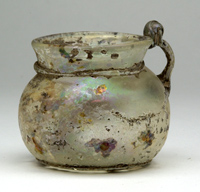 |
Unusual Single-handled Cup. Roman, 1st to 2nd Century AD. Cf. G.A.E. Vol 1, fig. 261. Height: 2-5/8". Blown in clear glass, this "cup" appears like a balsamarium jar in shape. With a wide, flared mouth, flattened ovoid body and folded ring base. A trailed decorative ring (in glass) decorates the neck, while a handle (also in clear glass) has been applied at the side. Intact and choice. With a lovely transparent iridescence in bright to pastel greens and reds.
Estimated Value $300 - 450.
View details and enlarged photo
| Realized
$546 |
Lot 4714 |
|
Withdrawn
| Unsold |
Lot 4715 |
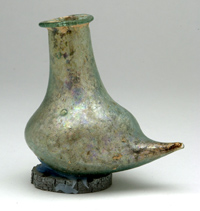 |
Interesting Bird Form Bottle. Roman, 1st to 2nd Century AD. Cf. Sammlung Opplander no. 574, but with trefoil mouth; A.G. pl. 62 (Palestine 3rd century AD). Height: 3-1/4". An unusual "novelty" bottle in avial form, this creative piece features a broad cylindrical neck with a flattened, outrolled rim. Its oblong, ovate body projects a "tail" extending out from the bottom side of flask. The bottom is flat. Blown from aqua-green glass, the vessel displays pleasing green, red, violet, and silver to copper iridescence. As is typically found, the tip of the tail is chipped, but the tail likely served as a dropper spout anyway. Otherwise the vessel choice. Rare!
Estimated Value $600 - 900.
View details and enlarged photo
| Realized
$1,150 |
Lot 4716 |
 |
Conical Bottle with Fine Iridescence. Roman, 1st to 2nd century AD. Cf. G.A.E. Vol. 1, fig. 66f. Height: 6-3/4". Simple, but finely proportioned and elegant, this flask has a modest funnel mouth with a carinated, rolled lip. The cylindrical neck flares into its narrow, conical body. Blown from clear or faintly yellow glass, the interior displays zoned iridescence in beautiful yellow, greens, purples, and blues, ranging from subdued and shimmering to brightly metallic. Intact and perfect. A delightful gem!
Estimated Value $500 - 700.
View details and enlarged photo
| Realized
$1,006 |
Lot 4717 |
 |
Choice Green Unguentarium. Roman, 1st to 2nd century AD. Cf. Daramki find, grave of the Wa'r Abu Es Safa, near Jerusalem (but perhaps of Syrian origin.). Cf. G.A.E. Vol. XII, pl. 89. Height: 4-3/4". Blown in a very thick green glass, this robust bottle has a rolled flange-like rim, a straight cylinder neck and a wide-flared, piriform body. Intact and perfect, with speckled glitter-like iridescence to superb shimmering blues, greens, lime, rust and coppery pink. Wonderfully colorful, without being strident.
Estimated Value $400 - 550.
View details and enlarged photo
| Realized
$891 |
Lot 4718 |
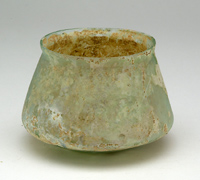 |
Iridescent Beaker or Jar. Roman, c. 1st to 2nd century AD. Cf. G.A.E. Vol. 1, pl. 65q; Hans Cohn Collection, fig. 120. Height: 2-1/2".Robust and with some heft, the cup offered here is blown in light green glass and features a short flaring rim and a sharply angled conical body set on a stepped, convex bottom. On the exterior, paired decorative grooves have been lightly engraved and encircle the lower part of body. A trivial ancient nick appears at the rim, otherwise the cup is intact and perfect. Iridescence is diffuse to sparkling, mainly in silver, cremes, and rose, with additional deeper green, blue and purple hues. A stylish shape.
Estimated Value $300 - 450.
View details and enlarged photo
| Realized
$184 |
Lot 4719 |
 |
Two Beautiful Minature Jars, in Yellow Glass. Roman, 1st to 3rd century AD. Cf. G.A.E. Vol. 1, pl. 67, for first; Smith, figs. 313, 314, 315, for second, also Opplander no. 578, with original bronze handle intact. Heights: 2-1/4'; 2-5/8". 1. The earliest of this pair is a "cosmetic cup" delicately blown with a wide funnel mouth set atop an inverted conical body that has rounded shoulders and a pinched waist. With a flat base. Intact and perfect, with a lovely opaquish silver-gold color that tends to greens and reds. 2. The second piece is a minature sprinkler flask with a shallow funnel mouth and cylinder neck that taperes to a constricting groove at the body junction. The squat tear or drop-shaped body sits atop a slightly raised foot. The bottle is robust and perfect with a green-brown internal patina and slight hints of iridescence. A delightful pair!
Estimated Value $350 - 550.
View details and enlarged photo
| Realized
$242 |
Lot 4720 |
 |
A Very Fine Patella Cup, in Finely Colored Green Glass. Roman, 1st to 3rd Century AD. Cf. Newark fig. 98. A scarce and fine, late example of this earlier shape. Height: 2-3/8". This footed, beaker-like cup is robustly made with a wide mouth and a broad, folded lip that forms a flaring collar around the piece. The collar has two shallow, heat-tooled grooves encircling its circumference. The wide foot is convex. Intact and superbly preserved with a faint, transparent green iridescence.
Estimated Value $300 - 500.
View details and enlarged photo
| Realized
$483 |
Lot 4721 |
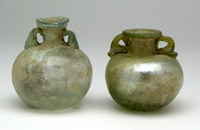 |
Two Attractive Aryballoi. Roman, later 1st to 3rd century AD. G.A.W. p. 212; G.A.E. Vol. 1, figs. 74, 335; Glass Museum Haarets, Tel Aviv, Photo #9; Newark, figs. 429 430. Heights: 2-3/8"; 2-5/8". A fine lot of 2. The first piece is thickly blown in leaf green glass, the other is more delicate in light green. Both bottles are of a similar shape -- with sharply everted mouths, loop handles that stretch from the collar to shoulder, and broad ovate bodies. The heavier bottle has a handle in lime green and a more flattend body. While the second bottle has a flared, folded mouth. Both are intact and perfect. The first with yellowish silver-gray-green iridescence; the other green bottle with light, cleanable earthen paitna.
Estimated Value $350 - 500.
View details and enlarged photo
| Realized
$414 |
Lot 4722 |
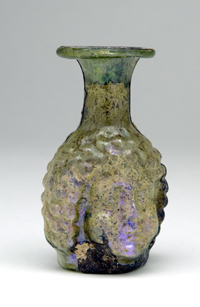 |
A Choice Iridescent Janiform Head Vase. Roman, possibly Syrian, c. 2nd century AD. Cf. Sammling Oppenlander no. 465, perhaps same workshop. Height: 3-1/8". Mold blown in in deep lime or leaf green glass, this bottle has a shallow funnel mouth and a usual cylinder neck. The body is in the form of two youthful male heads abutting, back to back. Perhaps the portrait is meant to represent Bacchus with hair in the form of globules that resemble a grape cluster. Intact and perfect, the jar is partly covered with cleanable black crust. The revealed side features a lovely, delicately transparent blue-green to cobalt-violet iridescence. Scarce, and always avidly sought out by collectors, be prepared to bid well for this one!
Estimated Value $1,250-UP.
View details and enlarged photo
| Realized
$2,415 |
Lot 4723 |
 |
A Choice and Important "Grape" Flask, Subtly Iridescent. Roman, likely Syria, c. 2nd to 3rd century. Cf. Sammlung Oppenlander, no. 470, an earlier version. Height: 5". Thickly blown ina more yellow than green glass, this bottle is robust. The shallow funnel mouth has a heavey rolled rim and the long cylinder neck is folded to create a platform-like shoulder to the body. The body is sharply molded with rows of globules as well as two small triangular leaves at the top. At the base is a slighlty raised foot. Exterior shows a light and delicate rose-silver iridescence, which, where flaked off, a shimmering multi-hued silver color glimmers throughout. Intact and perfect. Rare and important!
Estimated Value $1,000-UP.
View details and enlarged photo
| Realized
$3,450 |
Lot 4724 |
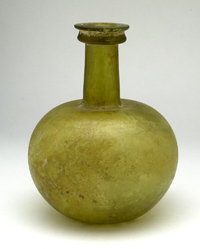 |
Handsome Large Bottle in Yellow Glass. Roman. possibly Syria, 2nd Century AD. Cf. G.A.E. Vol. 1, fig. 183. Height: 7". Blown from yellow glass with a faintly greenish tinge, this robust vessel has a folded, throated, and everted rim, a cylinder neck and a sharply ovoid body. Lightly engraved on the body are three pairs of encircling grooves. Intact and perfect. With slight areas of iridescence. An appealing larger vessel.
Estimated Value $500 - 750.
View details and enlarged photo
| Realized
$1,208 |
Lot 4725 |
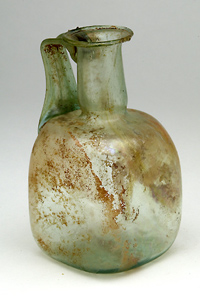 |
Small Square-sided Jug. Roman, c. 2nd century AD. Cf G.F.M. fig. 68, there Rhenish, late 1st to 2nd century AD; Newark, fig. 128. Height: 4-3/4". In light green glass, this jug has a flared, thinly rolled rim and a cylinder neck on its rounded, near cube-shaped body. Walls are perhaps mold-blown, as each appears to have a very faint, centered oval motif. A broad, combed, L-shaped handle is attached at the back. Intact and perfect. On one side brown deposits can be seen, but the majority of the pieces shows bright but transparent blue, green, and red iridescence.
Estimated Value $350 - 500.
View details and enlarged photo
| Realized
$518 |
Lot 4726 |
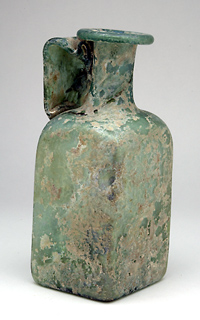 |
Large Rectangular Jug. Rome, 2nd to 3rd Century AD. Cf. Newark, fig. 128. Height: 8-1/8". Robustly made in heavy green glass, this piece features a flattened disc-like mouth with a rolled lip, and a broad cylinder neck atop rectangular body of square section. With slightly rounded shoulders and a concave base. A wide flat handle rises vertically from the shoulder to the neck. Chipping to an air bubble in the handle. Otherwise the bottle is finely preserved. With beautiful transparent to opaque purple and green iridescence.
Estimated Value $500 - 650.
View details and enlarged photo
| Unsold |
Lot 4727 |
 |
A Little Juglet in Green. Roman, 2nd to 3rd century AD. Height: 4". Blown in an attractive, thick leaf green glass this footed juglet featues a flattish rolled out rim on a thick, flaring neck atop a flattened ovate body. With a wide, folded and flaring foot. At one side is a trailed handle in the same color glass. Short, stable age cracks are scattered along the body with a larger crack at neck. Repair to inner mouth is noted. With some interior earthen patina and sporadic hints of colorful iridescence. Well crafted, an attractive object for display.
Estimated Value $300 - 400.
View details and enlarged photo
| Realized
$276 |
Lot 4728 |
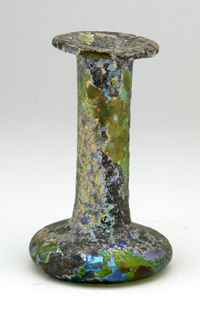 |
Thick Green Glass "Candlestick" Unguentarium, with Impressive Iridescence. Roman Syria, c. 2nd centu. Height: 3-1/2". This bottle is nearly spool-shaped and has a wide flang-like, straight cylindrical neck, with an equally broad, flattened disc-like body. The color of the glass is scarcely visible through the exceptional, intensely colored iridescence -- reflecting predominantly copper and green hues with cobalt accents. Intact and perfect. If one were but to own only a single example of ancient glass, why not this!
Estimated Value $300 - 450.
View details and enlarged photo
| Realized
$776 |
Lot 4729 |
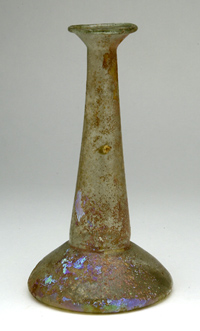 |
Long Necked Bottle with Vivid Iridescece. Roman Syria, 2nd Century AD. Cf. Harden Pl. XX Fig. 799. Newark Fig. 138. Height: 6-3/4". Blown from a clear to faintly green glass, this flask has a funnel mouth with a rolled rim. Its long, lightly funnel-shaped cylindrical neck expands down towards the flattened, conical body. Its base is slightly concave. The bottle is quite symmetrical and nicely porportioned, with speckles of exceptionally intense blue, green, purple to mauve, and gold iridescence. Intact and perfect. Choice!
Estimated Value $300 - 450.
View details and enlarged photo
| Realized
$529 |
Lot 4730 |
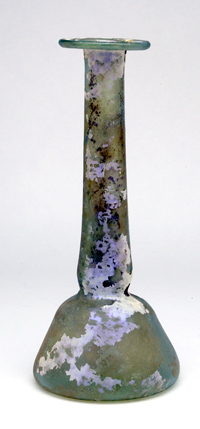 |
Iridescent Long Neck Bottle. Roman, 2nd to 3rd Century AD. Cf. Harden pl. XX, fig. 799. Height: 8-1/4". A fine bell-body unguentarium in light green glass. The broad discoid top has a rolled rim, and a long cylinder neck with a constricted base set atop a short and widely flared cone-like body. The base is deeply concave. Intact and perfect, with choice transparent to translucent iridescence tending to greens, limes, and coppers, plus beautiful and bright green, red to light blue, along with a soft shimmering creme- purple. Choice!!
Estimated Value $500-UP.
View details and enlarged photo
| Realized
$460 |
Lot 4731 |
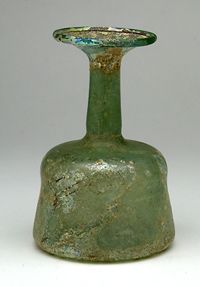 |
Flask with Bell-shaped Body. Roman, c. 2nd century AD. Height: 4-3/4". This bottle is heavy and robust and is blown from aqua-green glass. With a wide funnel mouth and inward folded rim, there is a narrow, slightly flaring neck attached to the broad body of the truncated cone shaped flask. A slight indention to the walls gives this bottle the appearance of an overturned goblet. Intact and perfect. With areas of vivid, somewhat golden iridescence. Attractive and well proportioned.
Estimated Value $350 - 500.
View details and enlarged photo
| Realized
$242 |
Lot 4732 |
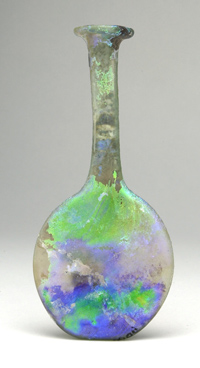 |
"Pilgrim's Flask" with Stunning Iridescence. Roman, c. 2nd to 3rd century AD. Cf. A.G. pl. 26; Newark no. 456; Hans Cohn Collection, no. 134. Likely of Palestinian or Syrian make. Height: 5-3/8". Blown in pale green glass, this bottle has a flared funnel-like rim and a narrow cylinder neck set upon a globular body with a flat base. Here the body is flattened into a to wafer-like thickness. The bottle is choice with very careful, expert repair to the body, however, the restoration is almost invisible amid the surface patina and vibrant irdescence. The time induced colors on this bottle are stunning! Vivid, softly metallic greens, blues, violets vibrate from the surface! This is what ancient glass is about -- time and nature forming a man-made oject into a true jewel!
Estimated Value $750-UP.
View details and enlarged photo
| Realized
$3,105 |
Lot 4733 |
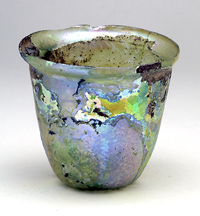 |
Beaker with Fine Iridescence. Roman, c. 2nd to 3rd century AD. Cf. Newark, fig. 501. Height: 3-1/4". Rather robust and heavy, this beaker is a delicate, inverted bell shape with a flared, cupped rim and curved, tapering walls. In pale green glass, the exterior displays superb iridescence in silvery violet to brilliant "peacock" greens, limes, reds, golds and coppers. With a moderate, stable age crack on one side, and modest ancient chipping to the rim. One not to be missed!
Estimated Value $400 - 600.
View details and enlarged photo
| Realized
$546 |
Lot 4734 |
 |
Large Cup or Bowl. Roman, c. 2nd century AD. Cf. G.F.M. fig. 99; Newark, figs. 36, 37. Height: 2-3/8"; Width: 5-1/8". Well crafted and finely proportioned in light green glass, this bowl has a shallow, flaring, funnel-type mouth with a rolled and folded rim, and rounded conical body set atop a folded ring foot. Large and delicately made, the bowl remains intact and perfect. With white earthen patina and patchy silver, blue-green, and magenta and rose iridescence. Very fine.
Estimated Value $400 - 600.
View details and enlarged photo
| Realized
$575 |
Lot 4735 |
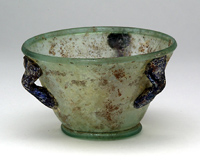 |
Triple Handled Cup or Lamp. Roman, 2nd to 3rd century AD. Cf. Newark, fig. 197. Height: 2-3/8". This funnel-shaped vessel is crafted in glass of light green color with three dark blue, opaque glass handles equally spaced around the sides. The tapered vessel has a wide mouth with a rolled rim and a folded ring foot. Faint green, blue, silver and purple iridescence appear on the cup and mottled purple, silver, green and black iridescence accent the handles. The cup is intact and choice; the handles are either reattached or are restorations.
Estimated Value $200 - 300.
View details and enlarged photo
| Realized
$345 |
Lot 4736 |
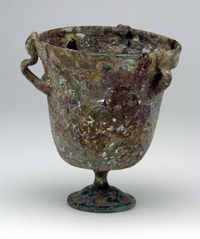 |
Unusual Lamp of Krater Shape. Roman Phoenicia, 2nd to 3rd century AD. For goblet shape, cf. G.A.E. Vol. 1, fig. 60b; Newark, fig. 198. Height: 4-1/4". Blown from pale green glass, this krater-lamp features a bell-like body on a narrow stem foot. The wide mouth has a rolled over and folded rim. Evenly spaced about the rim are three trailed, short loop handles of v-shape. Set within the center of krater bottom is a cylindrical projection with a rolled rim resembling the severed neck and rim of a small tear jar. The piece shows repairs and some "restorations." The glass is thickly encrusted on both internal and external surfaces with dirt and mottled gold, green, purple and copper iridescence. While odd, this piece looks more like like an ancient innovation rather than a recent pastiche (note especially lot no. 3396, following). It is being sold "as is."
Estimated Value $500-UP.
View details and enlarged photo
| Realized
$334 |
|
|